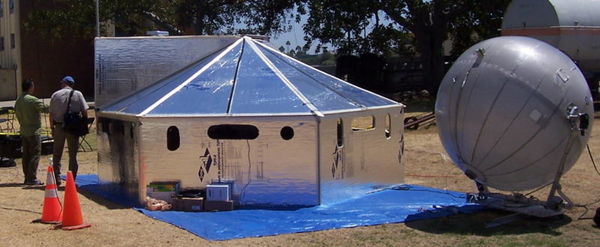Hexayurt Project
The Hexayurt is a new kind of sheltering solution.
To make the simplest Hexayurt, make a wall by putting six sheets of plywood on their sides in the shape of a hexagon. Cut six more sheets in half diagonally, and screw them together into a shallow cone. Lift the roof onto the wall with a large group of people, then fasten it down with more screws. Seal and paint it for durability. Your basic Hexayurt is complete.

This shelter will last for years in most climates and costs less than $100. This basic design can be improved with proper windows, doors, room partitions, stove fittings and other architectural features. More durable materials could give it a very long life.
It may be ideal for a variety of disaster relief situations.
Here are the key points.
- Hexayurts can be built in plywood/OSB for less than $100 for a 166 square foot (15 sq meter) building. See the Plywood hexayurt how-to video.
- Hexayurts can be made in a variety of sizes using simple tools from industry standard 4’x8′ (1.2×2.4m) sheets with zero waste and can be made successfully from many different materials, like plywood, OSB, coroplast, composites, hexacomb cardboard or other honeycombs and polyiso insulation boards. We also have new work from Edmund Harriss on quad-sized Hexayurt-like domes which share the zero-waste property with the Hexayurt itself. These are huge and very exciting.
- Hexayurts are public domain with no copyright or patent, meaning anybody can build as many as they like for free.
Depending on the choice of materials, a Hexayurt can last for years or even decades. In some long-term applications this could cut the cost of providing shelter to 10% of the cost of using standard relief tents. The Hexayurt enables regional shelter self-sufficiency, where in a crisis, pre-trained local builders or military personnel can work with first responders to rapidly create shelter from materials in the local supply chain, typically plywood or OSB.
The Hexayurt could prove particularly useful in areas with large scale repeated rehousing needs, such as the Hurricane Belt or flood-prone areas such as Bangaldesh. Materials can be trucked in from nearby unaffected areas at substantially lower costs than air-freighting in tents: in fact, the typical $100 air-freight on a $350 relief tent is enough to pay for one whole Hexayurt. We are actively seeking NGO partners to field-test this radically lower cost sheltering solution.
Science for Humanity is helping us coordinate research on the Hexayurt with scientific and engineering institutions.
Vinay Gupta @ http://hexayurt.com/





